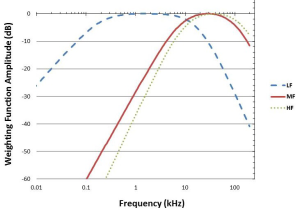We’ve just submitted our comments on the final proposed changes for the “Acoustical Guidelines” from NOAA Fisheries (aka National Marine Fisheries Service or NMFS). These are the guidelines defining sound exposure “Level A” impacts – i.e. physical damage – from hearing threshold shift (concert ears) to death due to noise exposure.

Original LF, MF, and HF Cetacean weighting curves
The “legacy” guidelines were predicated only on how loud a noise was; noise above a certain level would trigger regulatory guidelines regardless of what it sounded like or what frequencies were present. The proposed new guidelines divides marine mammals in hearing groups depending on their most sensitive frequency bands: Low Frequency for the great whales, Mid and High frequency for dolphins and porpoises, and two Mid frequency band curves for “true” seals (phocids) and sea lions and fur seals (otariids).
The Low Frequency curves for the great whales remains a “made-up” weighting curve due to the obvious constraint that no auditory testing has been done on this class of animal. One of our complaints with the proposed guidelines is that despite evidence to the contrary NOAA decided to provide a low frequency roll-off starting at 200 Hz – mostly to conform to the auditory weighting curves found in the other animals.
 NOAA took some heat for their “curve procedure” from the 2014 comment period and “nudged” it a bit to decrease the slope of the curve. But if you’re going to make it up and your mission statement hones in on conservation, why not open up the whole low end of the curve?
NOAA took some heat for their “curve procedure” from the 2014 comment period and “nudged” it a bit to decrease the slope of the curve. But if you’re going to make it up and your mission statement hones in on conservation, why not open up the whole low end of the curve?
The evidence supporting this suggestion (and really the only scant evidence we have on what these animals can hear) is that many of the phonations of the rorquals (blue, sei, fin, Bryde’s, and minke whales) are below 50Hz. Even humpbacks often phonate at down to 40Hz. Arbitrarily attenuating the weighting curve in this important band defies reason. It also would permit higher exposure levels in this LF band – which happens to be the playground of the seismic survey companies (odd that…).
The second shortcoming was NMFS creation of a cumulative sound exposure level (SELCUM) that “resets” after 24 hours. “Cumulative noise exposure” recognizes that exposures of lower level noise for long periods accumulates to inflict the same damage as short exposures to louder noises. Resetting this metric every 24 hours is also arbitrary and does not take into account the increasing sources of continuous noise we inject into the ocean – relentless, “around the clock” airguns, continuous navigation beacons, tidal altimeters, communications networks, vessel noise etc.
The third peccadillo was NMFS avoidance of recognizing that noise characteristics plays heavily into auditory damage. This is the “kurtosis metric” we have been pushing for over a decade now. If you are going to make up a threshold curve and take liberties with a cumulative sound exposure protocol, why not also use an established kurtosis metric to protect animals from particularly aggravating noise sources (like airgun surveys and digital communications systems?)
There remains some other problems with the document, but in the end the guidelines are an improvement over the legacy guidelines. Although it is a bit like buying a new car; it still has wheels and headlights, just a few more bells and whistles.
In the end – as the guidelines stand, there will be fewer “Level A Takes” from any given EIS. This will reflect to some degree the decreased impacts on animals from noises outside of their hearing regime. I suppose that this is an improvement, but as I mention on our 2015 comments – if residential noise ordinances were set up on how much you can damage the hearing of your neighbors, our cities and towns would be a different place to live.
